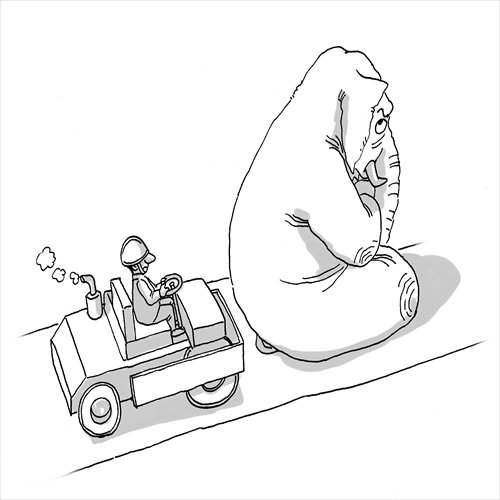


Illustration: Liu Rui/GT
Since China envisioned in 2013 the initiative of the Silk Roadeconomic belt and the 21st Century Maritime Silk Road, known as "One Belt and One Road," India has been following it closely. With a strong sense of its sphere of influence, New Delhi rejects the 21st Century Maritime Silk Road, as well as the Bangladesh-China-India-Myanmar economic corridor and the China-Pakistan economic corridor.
In particular, some Indian strategists and those from the military believe Beijing has geopolitical goals for its "One Belt and One Road" project and therefore spare no effort to prevent South Asian and Indian Ocean countries from participating it.
India first underlined that it has had interconnecting and interworking projects with its neighbors, especially Myanmar and Bangladesh. Then it proposed some countermeasures. The India government led by Prime Minister Narendra Modi presented the Mausam project before Chinese President Xi Jinping's state visit to India last September, but the project lacked substantial content in economic cooperation. Now New Delhi is working on the idea of Cotton Route with the hope of deepening trade, economic and cultural ties with Indian Ocean nations.
New Delhi primarily attempted to counter China's 21st Century Maritime Silk Road with these plans. But India is fully aware that a lack of funds will prevent it from successfully engaging in deepening economic cooperation with its neighbors and its plans will in no way substitute for Beijing's Maritime Silk Road. Therefore, it's more likely to use them as bargaining chips.
Many Indian strategists are sober-minded about the reality that New Delhi cannot impede its neighbors from collaborating with Beijing in infrastructure construction and should not thwart China's "One Belt and One Road" initiative in the region. They argue that India should instead participate actively in and exert influence upon the project.
Now, an increasing number of Indian scholars support New Delhi to join this giant project given India's dire need for infrastructure investment. In addition, India isn't included in the US-led Trans-Pacific Strategic Economic Partnership and the Transatlantic Trade and Investment Partnership, leaving the ambitious nation feeling marginalized on the world economic stage. Consequently, joining "One Belt and One Road" constitutes a helpful alternative.
There are signs that India expects to acquire a special position in the "One Belt and One Road" project. Some Indian scholars point out that New Delhi will not be content with playing second fiddle. Indeed, India's active participation will be helpful to itself, other South Asian and Indian Ocean countries as well as China. Nevertheless, if it intends to gain an advantage through blackmailing, it will never receive moral support from the region.
Modi's visit to three Indian Ocean countries in early March shows that India is determined to adopt an asymmetrical strategy to secure a dominant position in the Indian Ocean through bolstering military and security cooperation with these island nations.
According to Indian media outlets, the Mausam project envisages an Indian-led sea world covering the whole South Asia, East Africa, the Arabian Peninsula and extending to Southeast Asia. And the Indian navy will focus on establishing an India-centered regional order, where the Andaman and Nicobar Islands in the Bay of Bengal will be fully developed. In addition, the newly proposed Cotton Route plan will also put the emphasis on security. Such maneuvers of the Indian government have won endorsement from Washington and Tokyo. Therefore, New Delhi will probably play a negative role in the "One Belt and One Road" plan.
Carrying out political and security interaction and cooperation with India in the Indian Ocean and South Asia is key to the implementation of the "One Belt and One Road" initiative. The Chinese government should further improve its diplomatic policy and foster friendly ties with young people, businesses, media and non-governmental organizations of countries along the routes.
Meanwhile, it must take into account the security architecture needed during the implementation process and the establishment of a new, equal and accommodating security framework stretching from Asia to the Indian Ocean.
 J-11 fighters in air exercise
J-11 fighters in air exercise Beauties dancing on the rings
Beauties dancing on the rings Attendants-to-be join Mr. & Miss Campus Contest
Attendants-to-be join Mr. & Miss Campus Contest Beijing's toughest anti-smoking law takes effect
Beijing's toughest anti-smoking law takes effect Family lives in cave for about 50 years in SW China
Family lives in cave for about 50 years in SW China PLA soldiers operating vehicle-mounted guns in drill
PLA soldiers operating vehicle-mounted guns in drill Blind carpenter in E China's Jiangxi
Blind carpenter in E China's Jiangxi China hosts overseas disaster relief exercise for the first time
China hosts overseas disaster relief exercise for the first time 20 pairs of twins who will become flight attendants in Sichuan
20 pairs of twins who will become flight attendants in Sichuan Obama is sowing discontent in S.China Sea
Obama is sowing discontent in S.China Sea Rescuers work through night to reach cruise ship survivors
Rescuers work through night to reach cruise ship survivors Driving through limbo
Driving through limbo Facing down MERS
Facing down MERSDay|Week